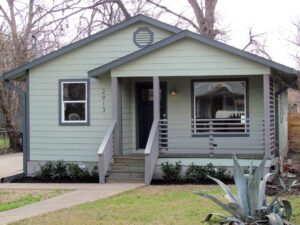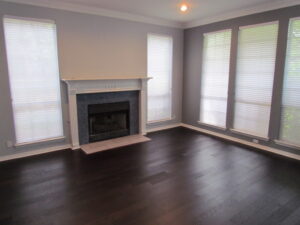Enjoy this guest post from Isabella Caprario contributor for Porch.com
Interested in flipping? Check out our House Flipping for Beginners Course.
A fixer-upper can be an opportunity to make some extra money if you know how to invest wisely. If you’re considering house flipping, there are plenty of crucial things to understand before you begin the process. From your specific market to making significant upgrades, every house flipping element plays a role in your final asking price. Read on to learn more about house flipping and how you can use it to your advantage.
What is House Flipping?
The term “house flipping” refers to buying a home with a short holding period, with the intent to resell it quickly. Unlike buying real estate as a long-term investment, house flipping is a short-term way to make some money after your initial investment. These short-term real estate transactions can allow you to leverage your asset to make a bit of money once the flip is complete. Most investors buy homes that require some updates and repairs at a low cost. The idea is to “buy low” and then “sell high” later after making a few changes, and you’re ready to put the home back on the market. It’s important to note that there are no guarantees with house flipping since the real estate market can fluctuate widely.
How to Get Started
If you want to get started with house flipping, there are some crucial things to keep in mind. Each of these items should be part of your house flipping endeavor so that you’re positive you are making a wise investment.
- Start the process by doing extensive research on the national and local housing market. Ask a real estate agent to provide you with some comps or comparable prices of homes in the recently sold area. You’ll also want to find out what buyers in your area are looking for in square footage, upgrades, and more. This research is vital to ensure you make a wise investment decision and buy a home that will sell quickly.
- Budget your house flipping plan so that you don’t end up paying too much for a property. Set a limit for how much you’re willing to pay, and never go over that amount when offering. Don’t forget to consider the budget for renovations and upgrades as part of your complete budgeting plan. It’s essential to find a home at the right price, so you know you’ll get the best investment return.
- Consider hiring a home inspector who can help you assess the necessary repairs the property might need. A thorough inspection will make it easier for you to determine the total repair costs before you make an offer.
- Once you have a better idea of your proposed asking price, you can subtract the home’s cost and all of the repairs and upgrades. The final number will be your bottom line and show you what you’ll gain financially once the flipped home is sold.
The House Flipping 70% Rule
Use the 70% rule of real estate investing to guide you when looking for homes to flip. This rule states that you should not pay more than 70% for the house after the repair value, minus all repair costs. The ARV (after repair value) refers to the estimated value of the property after all of the necessary repairs are complete. Let’s say the home has an ARV of $100,000 and requires $25,000 worth of repairs. The house flipping 70% rule would suggest that you pay approximately $45,000 for the home. This leaves you with 30% “wiggle room” to pay for miscellaneous repairs and other costs if needed, and it also accounts for the amount of money you’ll receive once it’s sold. Here’s a simple formula to help you see how this figure is calculated:
ARV of $100,000 x 70% = $70,000 – $25,000 = $45,000
The Importance of Ceiling Value
When you’re ready to sell a flipped home, it’s crucial to understand the ceiling value. This term refers to a maximum asking price that you can put on the house, and state or local governments often mandate it. If you ask for too much, the home could sit for a long time, making some buyers hesitant to put in an offer. Talk to an experienced real estate agent to help you determine a fair market value for the home. Feel free to start by listing the house for a bit more, since you can always negotiate the final price down with a potential buyer later.
Structural Improvements to Consider
Even if the home appears to be in decent shape, there are a few key upgrades you should take into consideration. If the home has old knob and tube wiring, a full electrical upgrade is advised. Inspect the plumbing and look for signs of rust or wear. Insulation should be in good condition, and the home should feel comfortable when the HVAC system is running. The roof should appear in good condition with no leaks or missing shingles. Take a closer look at the home’s main components first to determine if these improvements are necessary.
Room by Room Renovation Guide
Inspect every room of the home you’re planning to flip to determine what types of renovations they’ll need. Each part of the house may require some updating and improvements to get a better asking price.
- Façade: Paint the outside of the home or add new siding to give it better curb appeal. Cut down dead tree branches, lay down a fresh coating of grass seed, and update the landscaping to make the entrance more appealing. Fix any broken outdoor lighting or replace dead bulbs. Paint the front door a bold color to give the property an updated look.
- Bathrooms: Update the flooring and fixtures in the bathroom to make it look fresh and new. Make sure all plumbing is working correctly and that there are no signs of leaks. A simple tile job around the shower or tub can be an inexpensive yet significant improvement.
- Living Room: A fresh coat of paint and new flooring can quickly transform an outdated living room. If the home is “broken up” into several separate rooms, consider knocking down a wall to create a more open floor plan. Extend the windows and make them oversized to allow for more natural light.
- Kitchen: Replace outdated appliances with new stainless steel ones and consider updating old countertops to a solid surface like quartz or granite. You can repaint older kitchen cabinets to save money unless they’re broken or in disrepair.
- Garden: Check for pests’ signs and remove all weeds and dead plants from a garden area. Plant new flowers or shrubbery around the home to give it a fresh, lively aesthetic.
- Bedrooms: It’s easy to update bedrooms with new paint colors and new floors. A fresh coat of paint can do wonders for a bedroom. If the master closet is small, considering altering the layout to accommodate a larger closet.
- Laundry: Re-tile the laundry room and install a new washer and dryer if your budget allows. Install a sink in this room to make it more functional.
- Addition or Extension: If you have a larger budget, consider adding an extension to the home. This upgrade will be more costly and time-consuming, but it should also allow you to get a much higher asking price.
Adding the Most Value
Today’s modern homebuyers are looking for unique properties. If you want to add the most value to your house flip, make some current updates that will appeal to younger buyers. A glass railing along a staircase is a unique and modern choice that replaces the standard spindle design. High-tech upgrades like remote security cameras or doorbell alarm cameras are easy and affordable upgrades. Replace an old garage door with something sleek and contemporary. Energy-efficient windows will make the entire home look new, and it’s also a great incentive for buyers. Pay attention to the outside and install a new covered patio or deck. Many buyers enjoy spending time outdoors, so this is a great way to get more value for your flip.
Selling the Flip
Once your property is updated, it’s time to put it on the market. Enlist the help of an experienced, qualified real estate agent who is familiar with your local market. Check your listing to ensure that it has all of the home’s details, including the square footage, special features, and significant upgrades. Hire a professional photographer to take clear, detailed pictures of every room, including the home and the outside. With the right marketing plan in place, you can quickly sell your newly flipped home for a great return.
The process of house flipping isn’t for everyone, but it can be a smart investment choice if you have the know-how. Get to know your local real estate market and partner with professionals you can trust. Always stick to a budget when flipping houses, so you don’t end up paying too much. With the right updates in every room, it’s easy to quickly flip a house to get a great ROI.

 Homemade
Homemade


